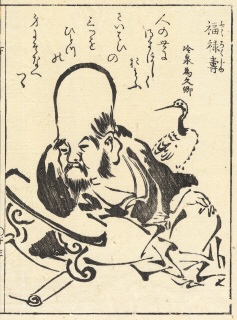On a Parcel-Gilt Wooden Stand
Depicting Fukurokuju, with applied gilt-plaque MIYAO
7in. (17.7cm) high, 13 1/2in (33cm) wide
The Miyao Company of Yokohama was founded by Miyao Eisuke, who, like many who founded manufacturing companies in this period, was not himself a craftsman, but rather an entrepreneur who gathered a group of artists and craftsmen under him. Few of these individual artists are known by name, but many of them would have been from families of traditional metalworkers, originally trained in the techniques used to decorate objects like sword fittings which, in this new Japan were no longer needed. When the samurais were banned from wearing their ceremonial swords in 1876, these sword-fitters turned their hand to new decorative arts, some working on their own, others joining companies like Miyao. These traditional tradesmen, highly skilled and readily educated in the techniques of the craft, were able to adapt their metalworking abilities onto smaller figures. Here they could produce amazingly detailed pieces of armour for the sculptures from iron lamella to tiny wrought swords. Such craftsmanship kept the metalworking industry alive whilst preserving the refinement of the Samurai tradition within the regal sculptures.
Eisuke’s company was one of the ‘second-rank’ factories, so called because instead of using the traditional but time-consuming technique of inlay, the details in the works they produced were surface-gilded. However, this label by no means indicated that their work was inferior; the detail and technique in these pieces is exquisite, and the company exhibited at both the Second and Third Domestic Industrial Expositions in Tokyo, in 1881 and 1909. Eisuke continued to manifest the public’s appreciation for Miyao sculptures by steadily increasing the number of legendary characters cast in bronze and only slightly altering older designs. His showrooms were filled with the choice of Japanese cast figures designed as koro, lamps and sculptures and his shop was considered one of the city’s most interesting sights due to its range of curios. Other examples of Miyao’s sculptures are held in museum collections, including the Victoria and Albert Museum in London.
Fukurokuju is one of the Seven Lucky Gods in Japanese mythology




















